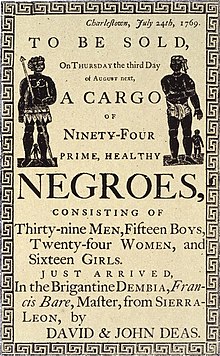Perdagangan hamba Atlantik
Jutaan orang Afrika Barat diculik atau direman dalam kapal-kapal perdagangan secara paksa merentasi Lautan Atlantik oleh kuasa-kuasa Barat menuju benua Amerika diperhambakan mengerjakan ladang-ladang tebu, tembakau, koko dan kapas, lombong emas perak, serta menjadi pembantu rumah dan buruh kilang[1] sana dari abad ke-16 hingga 19.[2] Kuasa-kuasa Barat ini mengikut jumlah hamba didagangkan[3] adalah Portugal, Britain, Sepanyol, Perancis, Belanda, Amerika Syarikat dan Denmark.[4][5][6][7]

Sebanyak kira-kira 12 ke 12.8 juta orang Afrika diangkut merentasi lautan Atlantik selama 400 tahun[8][9]:194 tidak termasuk 1.2–2.4 juta hamba belian yang mati dalam perjalanan dan dikurung sebaik mendarat di Caribbean serta banyak lagi yang mati di benua Afrika akibat peperangan diserang penjual hamba abdi serta cubaan melarikan diri.[10][11][12][13]
Rujukan
sunting- ^ Covey, Herbert C.; Eisnach, Dwight, penyunting (2009). "Slave Cooking and Meals – Arrival in the Americas". What the Slaves Ate: Recollections of African American Foods and Foodways from the Slave Narratives. Santa Barbara, California: Greenwood Press. m/s. 49–72. ISBN 978-0-313-37497-5. LCCN 2009003907.
- ^ "The history of the transatlantic slave trade". National Museums Liverpool. 10 July 2020. Dicapai pada 26 March 2021.
- ^ Español: Numero de esclavos embarcados para el trayecto transatlántico por pais desde 1400 hasta 1866, 2023-06-09, dicapai pada 2023-06-13
- ^ Español: Esclavos embarcados hacia América desde 1450 hasta 1866 por país, 2023-06-18, dicapai pada 2023-06-18
- ^ Henry Louis Gates Jr. (April 22, 2010). "Opinion – How to End the Slavery Blame-Game". The New York Times. Diarkibkan daripada yang asal pada April 26, 2010. Dicapai pada March 22, 2022.
The historians John Thornton and Linda Heywood of Boston University estimate that 90 percent of those shipped to the New World were enslaved by Africans and then sold to European traders.
CS1 maint: bot: original URL status unknown (link) - ^ Sowell, Thomas (2005). "The Real History of Slavery". Black Rednecks and White Liberals. New York: Encounter Books. m/s. 121–122. ISBN 978-1-59403-086-4.
- ^ Thornton, p. 112.
- ^ Ronald Segal, The Black Diaspora: Five Centuries of the Black Experience Outside Africa (New York: Farrar, Straus and Giroux, 1995), ISBN 0-374-11396-3, p. 4. "It is now estimated that 11,863,000 slaves were shipped across the Atlantic." (Note in original: Paul E. Lovejoy, "The Impact of the Atlantic Slave Trade on Africa: A Review of the Literature", in Journal of African History 30 (1989), p. 368.)
- ^ Ralat petik: Tag
<ref>tidak sah; tiada teks disediakan bagi rujukan yang bernamaMartin - ^ Patrick Manning, "The Slave Trade: The Formal Demographics of a Global System" in Joseph E. Inikori and Stanley L. Engerman (eds), The Atlantic Slave Trade: Effects on Economies, Societies and Peoples in Africa, the Americas, and Europe (Duke University Press, 1992), pp. 117–44, online at pp. 119–120.
- ^ Stannard, David. American Holocaust. Oxford University Press, 1993.
- ^ Eltis, David and Richardson, David, "The Numbers Game". In: Northrup, David: The Atlantic Slave Trade, 2nd ed., Houghton Mifflin Co., 2002, p. 95.
- ^ Basil Davidson. The African Slave Trade.